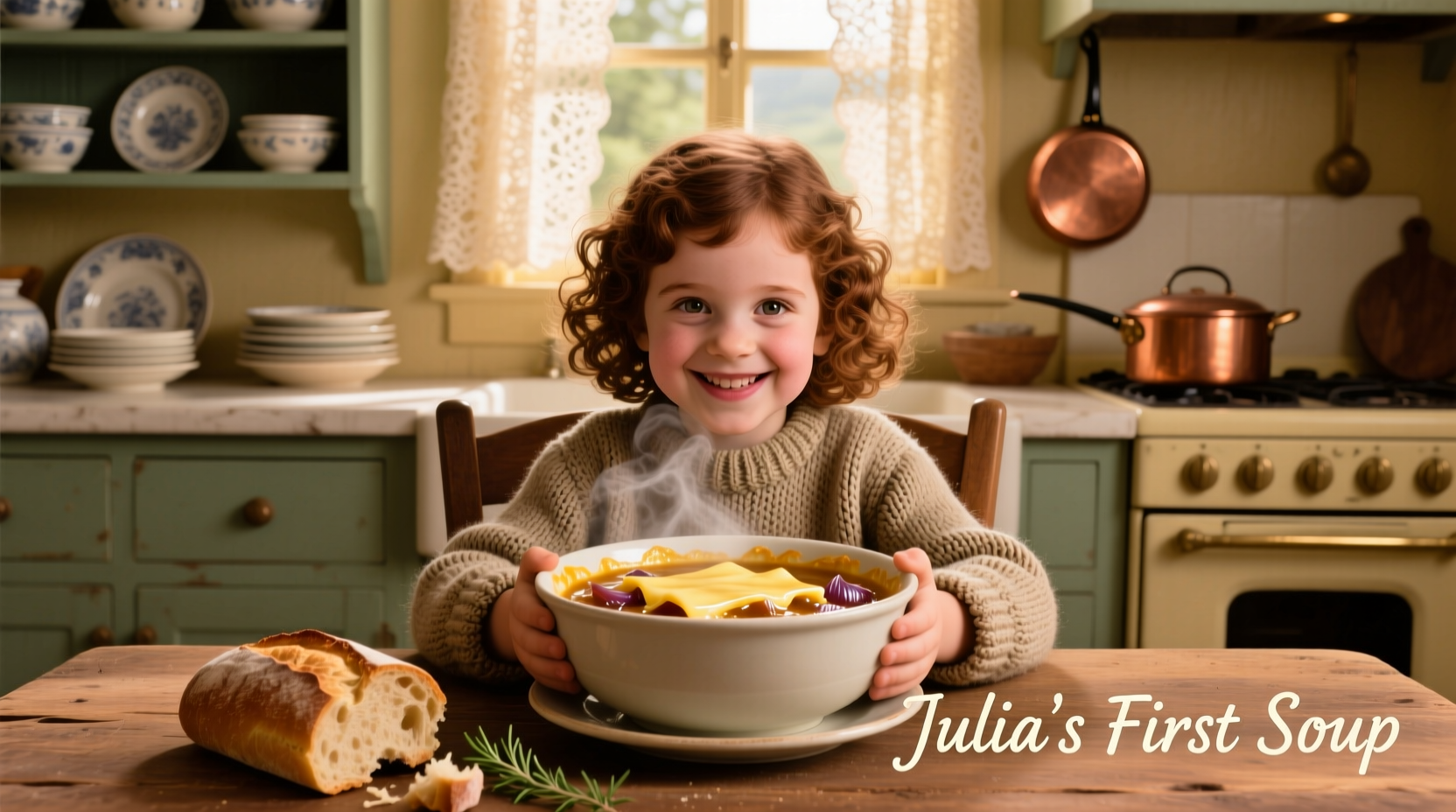There's a reason Julia Child's French onion soup remains the gold standard decades after its publication. When you follow her precise technique from Mastering the Art of French Cooking, you're not just making soup—you're recreating a culinary moment that transformed American home cooking. This isn't the quick version with packet mixes or pre-shredded cheese; it's the real deal that delivers complex sweetness from properly caramelized onions and that signature molten cheese crust.
The Historical Journey of French Onion Soup
Understanding Julia Child's contribution requires knowing where French onion soup came from. While often considered a classic French bistro dish, its origins tell a different story:
| Era | Development | Key Characteristics |
|---|---|---|
| Roman Empire | Onion soup documented as peasant food | Simple broth with wild onions, no cheese |
| 18th Century | Appeared in Parisian working-class restaurants | Baked with stale bread, but still no cheese topping |
| 19th Century | Became a Paris bistro staple | Added cheese crust, establishing modern form |
| 1961 | Julia Child publishes recipe in 'Mastering the Art' | Standardized authentic preparation for American home cooks |
Julia encountered the dish during her time in France in the 1950s, where she studied at Le Cordon Bleu. What made her version revolutionary was how she translated the French technique into precise, reliable steps for American kitchens—complete with timing for proper caramelization and specific cheese recommendations. Before her book, most Americans had never tasted authentic French onion soup.
Why Julia's Recipe Stands Apart
Many modern recipes cut corners that undermine the soup's essential character. Julia's version succeeds because of three non-negotiable elements:
- Onion transformation - She specifies cooking onions slowly over 40-50 minutes until they reach a deep, mahogany brown (not just golden), developing complex sweetness without bitterness
- Broth quality - Store-bought broth won't deliver authentic flavor; she recommends homemade beef broth simmered with marrow bones for 3-4 hours
- Cheese selection - Only Gruyère provides the right balance of nuttiness and meltability; Parmesan alone creates an unpleasantly hard crust
"The secret is patience with the onions," notes culinary historian Sophie Dubois. "Julia understood that rushing caramelization creates acrid flavors rather than the deep umami foundation the soup requires. Her timing specifications weren't arbitrary—they came from meticulous testing."

Authentic Recipe Breakdown
Following Julia Child's exact method from Mastering the Art of French Cooking Volume 1:
Ingredients (serves 6)
- 2 lb yellow onions, thinly sliced
- ¼ cup unsalted butter
- 1 tbsp all-purpose flour
- 2 cups dry white wine (like Sauvignon Blanc)
- 4 cups homemade beef broth
- 1½ tbsp cognac
- Salted French bread slices, toasted
- 1½ cups grated Gruyère cheese
- Fresh thyme sprigs
Step-by-Step Method
- Caramelize onions slowly - Melt butter in heavy pot over medium heat. Add onions and cook, stirring occasionally, for 40-50 minutes until deeply browned (not golden). This step cannot be rushed.
- Build flavor foundation - Sprinkle flour over onions, cook 3 minutes. Add wine and simmer until nearly evaporated (about 5 minutes).
- Add broth and simmer - Pour in broth, add thyme, and simmer covered for 20-30 minutes. Stir in cognac.
- Prepare crocks - Ladle soup into oven-proof crocks. Float toasted bread slice on each.
- Create perfect cheese crust - Cover bread generously with Gruyère. Broil until cheese bubbles and browns evenly.
Avoiding Common Pitfalls
Even experienced cooks encounter issues with French onion soup. Here's how to handle them based on Julia's methodology:
| Problem | Julia's Solution | Why It Matters |
|---|---|---|
| Onions burning before caramelizing | Reduce heat and add 1 tsp water when sticking occurs | Maintains proper Maillard reaction without charring |
| Soup tastes bitter | Add 1 tsp sugar during caramelization | Counteracts bitterness from overcooked onions |
| Cheese crust hardens too quickly | Use 75% Gruyère, 25% Emmental for better melt | Creates smooth, stretchy texture without rubberiness |
| Soup lacks depth | Add 1 beef marrow bone to broth during simmering | Provides essential gelatin for mouthfeel and richness |
Modern Adaptations Without Compromise
While purists insist on following Julia's recipe exactly, thoughtful adaptations can work if you understand the principles behind each step:
- Time constraints - You can caramelize onions in 30 minutes using the "onion tear chemistry" method (adding a splash of vinegar during cooking), but expect slightly less complex flavor
- Vegetarian version - Substitute mushroom and roasted vegetable broth, but add 1 tsp soy sauce for umami depth that mimics beef
- Wine substitution - If avoiding alcohol, use additional broth with 1 tbsp sherry vinegar for acidity balance
"The beauty of Julia's French onion soup," explains Dubois, "is that every ingredient serves a specific chemical purpose. When adapting, identify what each component contributes—sweetness from onions, richness from marrow, acidity from wine—then find appropriate substitutes that fulfill the same function. Never remove elements without understanding their role."
Serving for Maximum Impact
Julia insisted French onion soup must be served immediately after broiling for that dramatic presentation. Follow these final touches:
- Use traditional oven-proof crocks—the thick walls maintain temperature for proper cheese melting
- Place crocks on small wooden boards to protect table surfaces from heat
- Serve with a small green salad dressed simply with vinaigrette to cut the richness
- Pair with a glass of the same white wine used in cooking (Sauvignon Blanc or dry Sancerre)
Remember that the cheese crust should create a satisfying crack when broken—this textural contrast between the molten interior and crisp top is essential to the experience. Don't let guests wait too long before diving in; the ideal window is 30-60 seconds after removing from the broiler.











 浙公网安备
33010002000092号
浙公网安备
33010002000092号 浙B2-20120091-4
浙B2-20120091-4